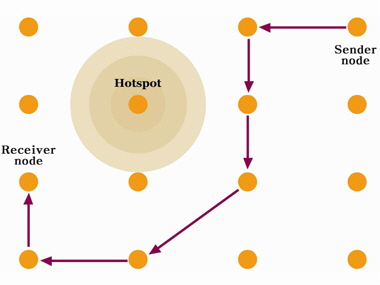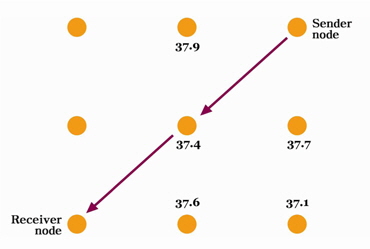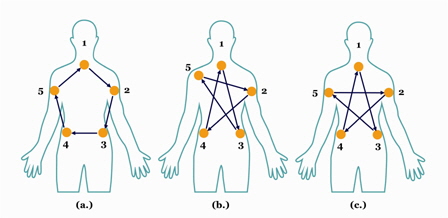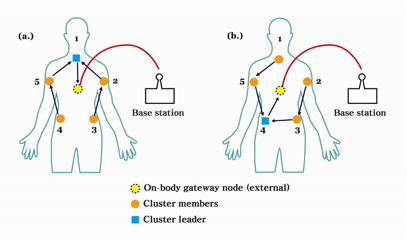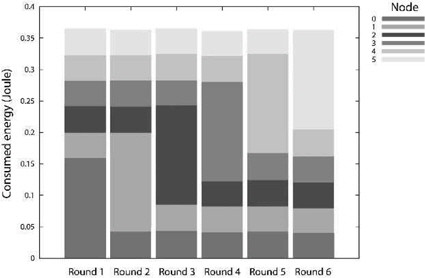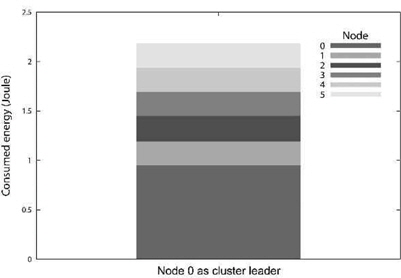



In recent years, the advancement of high-performance microprocessors, sensing materials, and device miniaturization techniques has stimulated considerable interest in the development of sensors that can be implanted inside the human body [1, 2]. The applications of these sensors are extensive, and it is impossible to describe all the uses of these devices [3].
The technology for biomedical sensors is still relatively new [3].
These wireless sensor nodes communicate with each other to coordinate activities, process data, and wirelessly transmit data to a base station that is often in an ambient network, e.g., a hospital ward. Since these devices are composed of electronic circuits, prolonged communication, data processing, or even sensing causes the sensor node to heat up, thus increasing the temperature of the surrounding tissue. When human tissue is exposed for long periods of time to this relatively high temperature, there is a tendency for it to get damaged.
Developing routing algorithms, particularly in body sensor networks, is very challenging due to the limitations of these devices [4]. On-body channels pose more of a challenge because of the effects of the body that detunes and distorts the radiation pattern of the antenna and acts as a bulk absorber [1, 5]. In addition, even gender and body shape considerably affect the signals. Researchers in [5] were able to prove that when attached on the body of a male volunteer, signals suffered higher path loss and more fading than signals from sensors attached on female subjects.
Over the years, researchers have developed protocols that enable sensor nodes to use withdrawal strategies whenever the temperature of one of its neighbors exceeds a predefined threshold. This node is then marked as a hotspot (Fig. 1), and packets are either routed away or around this area.
In [6], the researchers explored the factors that lead to the temperature increase, and the process for calculating the specific absorption rate (SAR) and the temperature increase of the implanted biosensors by using the finite-difference time-domain method. In their work, they improved the performance of a body area network by rotating the cluster leader on the basis of the leadership history and the sensor locations. They proposed a simplified scheme for a temperature increase potential that efficiently predicts the temperature increase in tissues surrounding the implanted sensor devices.
In [7], the researchers proposed a new routing algorithm that reduces the amount of heat produced in the network. In the simple form, the algorithm routes packets to the coolest neighbor without inducing routing loops. This is shown in Fig. 2. In the adaptive form, the algorithm uses mechanisms to adapt to topologies with a low degree of connectivity and to switch to the shortest path routing algorithm if the time threshold is exceeded. The proposed algorithm performs considerably better in terms of reducing the amount of heat produced, delay, and power consumption as compared to the shortest hop routing algorithm and a previously proposed thermal-aware routing algorithm (TARA) [8].
The goal of the clustering algorithm is to construct a cluster set that includes all of the user nodes, and can better support the resource management and interconnection of the routing protocols. In this study, the clustering algorithm used is further improved to support communication with a mobile gateway. Cluster heads are designed to communicate directly with the mobile gateway instead of ordinary nodes using multiple hops to relay messages to the mobile gateway.
>
B. Temperature-Aware Routing (LTR & ALTR)
The SAR is defined as power absorbed per unit mass of the tissue, a measure for determining the amount of power lost due to heat dissipation. In body area network (BAN), the SAR should be taken into account, either locally or globally, by using its average over the entire mass of the tissue between the transmitter and the receiver. Because of the SAR consideration, the thermal effects of BAN should be considered in the routing protocol [2].
In this study, least temperature routing (LTR) and adapive least temperature routing (ALTR) [7] are used as the routing protocols of the nodes. The functions of LTR and ALTR are as follows.
Routing: If the destination node of the packet is a neighboring node, the packet is forwarded directly to its destination node. We assume that each node has information about the temperature of its neighbors. The node forwards the packet to the neighbor having the least temperature or the “coolest neighbor” if the destination node is not one of its neighbors [7].
Reducing unnecessary hops and loops: Each packet maintains a small list of nodes that it has most recently visited. If the “coolest neighbor” is already there in the list of recently visited nodes for the packet, the packet is forwarded to the neighbor having the second lowest temperature among the neighboring nodes. The list of recently visited nodes should include all nodes visited within some past window [7].
The ALTR protocol is similar to the LTR protocol with a small improvement to minimize the packet delivery delay. To minimize the delay, if the hop-count is less than or equal to a threshold value, the packet is routed following the rules of the LTR algorithm. If the hop-count is greater than the threshold value, the packet is routed using the shortest hop routing (SHR) algorithm [7].
>
C. Clustering Leadership Rotation
All the nodes are given the chance to be the “leader” of the cluster. By doing this, all the members of the cluster have sufficient time to cool down, thus cooling down the surrounding tissues.
In determining the next leader, the following two factors are significant: the location of the next leader and the leadership history. For example, consider the simple cluster of five sensor nodes depicted in Fig. 3(a) and a rotation sequence, which we denote as the nearest node rotation (NNR) sequence [6]. For the farthest node rotation (FNR), we select the next leader on the basis of its Euclidean distance from the current leader. Therefore, the rotation sequence is as shown in Fig. 3(b) [6].
Now consider the scenario with a sequence that has an evenly distributed location (Fig. 3(c)). We call this the ideal node rotation (INR) sequence. By comparing the temperature increase results of the NNR sequence, FNR sequence, and INR sequence, we investigated whether the leader rotation history and the sensor locations have an influence on the temperature increase [6].
Communicating with a gateway or a base station requires the most energy and therefore, produces the most heat. It is assumed that aside from the sensor nodes, there is a separate sensor (preferably, externally located) that gathers all the data from the “cluster leader.”
Instead of considering multiple clusters of sensor nodes on a single human body, we treat all sensors as belonging to 1 cluster. All these sensors follow the cluster leader rotation technique explained earlier. The node that gets elected as the leader is responsible for communicating with an externally attached gateway or directly to the base station. The setup for rotating leadership among the sensor nodes is illustrated in Fig. 4. Each time a new leader is selected, this leader becomes the node responsible for sending data to the onbody gateway node or a base station.
Other nodes (cluster members) should follow LTR or ALTR for forwarding data towards the sink node, which in this case, also acts as the cluster leader.
A preliminary experiment was conducted using Castalia. The simulation used the Zigbee protocol, and the setup was a basic BAN cluster composed of 6 nodes. To simulate all nodes sending data to 1 sink node, we used a Throughput-Test application for the 5 nodes. The rest of the settings for the Castalia simulation are shown below:
Each of the 5 cluster nodes were given the chance to become the cluster head to communicate with the sink. Fig. 5 shows the total energy consumed by the nodes. In this figure, we also observe that the nodes consume a significantly larger amount of energy when they are assigned as the cluster heads.
These results are then compared to those of a simulation that used the same configuration but did not use leader rotation. The results of the second simulation are shown in Fig. 6.
As you can see in Fig. 6, node 0 spends most of the energy for the entire duration of the simulation (almost 1 J for a simulation time of 360 seconds). In contrast, all of the nodes’ spent energy in the first simulation (Fig. 5) is below 0.4 J for a simulation time of 360 seconds. This implies that the tissue around this particular device will significantly heat up as compared to the other devices.
When Fig. 6 is compared to the previous figure, we can see that cluster leader rotation results into a more distributed energy consumption among the nodes. The result is two-fold. None of the devices rapidly spends all its energy, and all the sensor devices have sufficient time to cool down, thus cooling down the tissue surrounding them.
The goal of this study is to decrease the average temperature of the body sensor network. Simulation results for a 4 × 4 regular mesh network in a previous study showed that in terms of the average temperature rise in the network, LTR and ALTR performed better than SHR and TARA.
The simulation results reported in a previous work showed that different rotation sequences result in different temperature increases. This means that there is an ideal way to select the next leader node. Leadership history and the locations of the sensors should always be considered, and this requires an adaptive strategy for selecting the cluster leader rotation technique.
When cluster leader rotation techniques will be implemented with either LTR or ALTR routing protocols, the average temperature of the network will be significantly decreased as well as that of the surrounding tissues.
